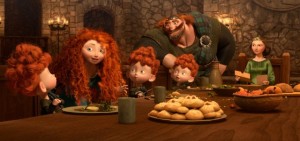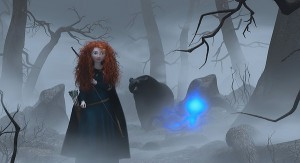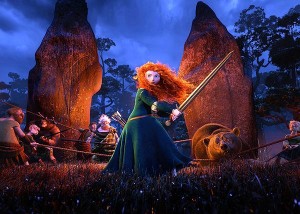
There’s nothing really actively wrong with Pixar’s latest, Brave, but, frankly, this tale of female empowerment in ancient Scotland fell far short of wowing me. Oh, sure, the animation is fine and the voice work is utterly professional. It’s a good-looking picture and it moves like clockwork. Maybe that last is where my problem arises. All too often, I felt like I was marking time waiting for the fairly obvious plot to follow its inevitable course. By the time it was over, I felt like I’d simply sat through a film that was marking off a checklist—something perfectly professional, but lacking the one thing professionalism can’t replace: inspiration.
Someone pointed out to me that aspects of the movie are strikingly similar to Disney’s Brother Bear (2003)—something that hadn’t occurred to me, simply because I haven’t given a minute’s thought to Brother Bear in nearly nine years. My suspicion is that nine years from now, I will have devoted about as much thought to Brave, which is only able to sort of live up to its title by stacking its deck.

There’s certainly something worthwhile, albeit not that new, to be mined from a story about a princess (Kelly Macdonald) who prefers to make her own choices rather than follow the life that has been mapped out for her. Its value lies, or should lie, in making the princess’ decision to be her own woman completely a matter of principle, but the film cheats in this regard. It chooses to make her refusal to marry be based on the fact that her three sanctioned prospective swains are as big a trio of doofuses as could be imagined. Indeed, she perks up at the prospect when she briefly thinks a hunky guy is among them, only to learn her actual suitor is standing behind said hunk. This considerably reduces the apparent message.

The thrust of the story lies in Princess Merida coming across a bear-obsessed witch (Julie Walters) who—in exchange for Merida buying all her woodcarvings of bears—gives the girl a potion that will transform her mother, Queen Elinor (Emma Thompson). Of course, what it changes her into isn’t an understanding mother, but a bear, causing no end of trouble in part because King Fergus (Billy Connolly) has it in for bears ever since one ate his leg. Some mirth and a good deal of adventure follows, all of which is complicated by the fact that if the spell isn’t reversed by dawn of the second day, poor mom will permanently remain a bear.
There are a few—surprisingly few—clever gags, a couple of not especially memorable songs, the requisite big climax and life-lessons learned. Fine, but not fine enough to make Brave anything more than OK. Rated PG for some scary action and rude humor.




Before we get into my thoughts on
Was it just me, or did anyone else feel like it amounts to an astounding
I would like to address the short film
Problem is that “ohh” moment was obvious way before we got to it.
I hope I don’t sound supercilious, it’s a little amusing to watch the commentators on Rotten Tomatoes bemoaning the fact that Pixar is in decline after Cars 2 and Brave.
Why have we always treated this studio like some kind of auteur? It has an entire stable of directors of widely varying talent.
Why have we always treated this studio like some kind of auteur?
I have never understood that, but I never found the films all that special in any overall sense. (Cue the defenders of the faith!)
Not a defender of the faith (though I’ve generally liked Pixar more than Mr. Ken, at least until CARS, with RATATOUILLE and UP excepted). But as far as studio seen as an auteur, that’s not surprising or shocking with animation, especially feature films, given the collaborative or even “factory” nature of it. Think of “Disney,” after all, and the same attitude and verbiage has been applied to Aardman (fairly rightly so, especially since design aesthetics like the teeth, the bead-with-pinhole eyes, etc. are consistent no matter who directs, but Nick Park and Peter Lord are generally seen as the main movers there). It’s also been said of Dreamworks, more specifically their CG featured, which have uniformly involved wisecracking, usually animal characters, pop culture references and smarm, etc. and where I have no idea even who directed a given film, but they have the same crew of directors and storymen who seem to get credit almost on a rotation basis. Not as sentimental or even cloying as is often associated with Pixar
A few feature animated film directors, Don Bluth or Ralph Bakshi, for all their flaws, were their own no matter what studio they were with, and shorts are a different matter, or could be. Disney shorts have a studio “look” regardless of director, usually with individual animators doing more to break out, and similarly with the features, thus the cult of the “Nine Old Men” and which characters they created, as opposed to the directors of the film, which often broke down into “sequence directors” but really with the “directing animators” controlling their characters, scenes and sequences. Obviously Warner shorts were the opposite, where once you get past the 30s, it’s easy to pick out a Jones from a Freleng from a Bob McKimson and they also mostly had their own units (whereas animators at Disney, Lantz, or at times MGM were more apt to work on everything under every director).
Pixar, to a large extent, is identified with John Lasseter, who directed the first three features and has produced everything. The “stable” of directors is mostly a group of co-directors (Brad Bird, a genuine auteur, excepted) and mostly the same people who worked on all the films in some capacity, from story to lead animators: Pete Docter (whose UP is the best of Pixar in the last few years), Andrew Stanton, Lee Unkrich finally soloed with TOY STORY 3 but Lasseter and Stanton co-wrote and it continued the franchise. Clearly the obsession with talking objects is especially Lasseter’s and possibly Stanton’s (ugh, PLANES!) BRAVE is perhaps unique, outside of Bird’s films, in clearly showing more of the work of the director than the established “Pixarians.”
As far as the collaboartive aspect is concerned, I’m not quite sold on it for the simple reason that the two best animated films — for me — from the US since the turn of the century have been Lilo and Stitch and Up, both of which are essentially the visions of a couple of people more than a committe.
Right, although even UP had a co-director/co-writer for the screenplay, Bob Peterson. But that’s the distinction, whereas the others (MONSTERS INC., TOY STORY and sequels, FINDING NEMO, BUG’S LIFE) had the same group of multiple people, just perhaps sliding out who had what role, wth Docter, Stanton, and Lasseter, and the late story head Joe Ranft as the main constants These all also had many writers *and* huge storyboard teams, which in animation usually occurs before a screenplay and in some cases there is no real screenplay. MONSTERS INC. had five different names (including Stanton and Docter) credited for story and screenplay, and about a dozen or so story artists/additional story/etc. WALL-E was mostly Stanton but again co-written with Docter, with Lasseter as producer having at least some input (although likely less than FINDING NEMO, from the audio commentary and story session footage of that; I never bothered to buy WALL-E so).
In contrast, LILO AND STITCH, although again there’s shared director credit (with Dean Deblois), Chris Sanders came up with the original story concept, he and Deblois were the only screenwriters, with a mere four other folks credited with story, and at least some of them just from other stages of the film (a true rarity; I’ll pull out my DVD later to double check just in case, but)… INCREDIBLES, Bird directed and wrote the screenplay *and* original story, with the usual brace of storyboard artists, but still, a rarity. RATATOUILLE, Bird also wrote the screenplay but shares credit for story and direction with Jan Pinkava, since it was Pinkava’s originally. The final product is definitely Bird’s as a movie, but some of Pinkava’s stuff before he was yanked is still there, and while that’s also happened many a time in live-action, it happens in animation more *because* the director is faceless to the public, because storyboards can be turned over to someone else. Chris Sanders was himself booted from a Disney feature originally planned to be hand drawn, then called AMERICAN DOG… which finally came out as BOLT under different hands and unrecognizable. (To say nothing of how the Latin American epic KINGDOM OF THE SUN became EMPEROR’S NEW GROOVE with practically everyone originally involved having their work dumped or changed beyond recognition, with a movie THE SWEATBOX made about it but mostly since suppressed by, well, Disney; it began as one of those “making of” documentaries and ended up as a sort of too revealing look at the factory aspect).
Definitely auteur theory can apply to animation and animated features (I mentioned several examples myself, Bird, Bluth, Bakshi; and of course, FANTASTIC MR. FOX, the actual animation director was Mark Gustafson, but the auteur is Wes Anderson, and that’s why most people forget that Henry Selick directed NIGHTMARE BEFORE CHRISTMAS, Burton doesn’t even get director credit on that, because the look, the story, the character designs, the theme, *everything* has Burton’s stamp). But with a lot of Pixar, if there is a stamp, it’s Lasseter or the core group I mentioned. When the auteur emerges, either a newcomer like Bird or from within the group, it’s because they *make* their vision dominate rather than just collaborating with all the co-directors and committee. WALL-E is a far more personal film than FINDING NEMO; whether it’s better is entirely subjective. UP versus MONSTERS INC. is unquestionably both more personal AND a better movie (so no surprise which one the Pixar group is choosing to make a sequel/prequel/whatever to). So that’s all why Pixar the entity is seen as the auteur, plus input from all the other levels (directing animators, animators, layout, rendering, technical). Lasseter usually oversaw all of it, but when he doesn’t, unless someone like Bird or Docter does and personally chooses their collaborators or even helps form them into a “stock company” (ala Sturges using the Paramount contract players), it just becomes, if not work by committee, certainly something from an assembly line (just sometimes a particularly well-organized assembly line, with the best tools and shiniest output). That’s why more animation auteurs either direct very rarely or outside of a larger studio entity, or stick to shorts or indie financed features or PBS specials (see Bill Plympton, or outside the US, Sylvain Chomet; still plenty of collaborators but the auteur’s stamp is everywhere and nobody can take a project away from them and stick in a different cog).
So all-pervasive is the Burton imprint of Nightmare in the public’s mind (though I think a case can be made the strongest voice in it is Danny Elfman’s), that one major paper ran a banner on down the road proclaiming “Tim Burton’s new film Coraline” was opening.
Of course, it’s a simple enough fact that studios have long had a look or feel of their own. (At least when the idea of a studio had any meaning, which may now be limited to animation departments.) You’d never mistake a Lubitsch, Mamoulian, or Sternberg picture from their greatest periods as being anything but their work, but they all also look like a Paramount Picture. You can play the same game with Universal and Warner Bros — and maybe MGM, but there it’s almost never a positive thing. I would not, however, accuse any of them of being the auteur. Well, maybe MGM — and in the same stranglehold manner as Pixar or Disney.
I freely admit I am not a huge animation fan. The only Disney film I own is Lilo and Stitch and the only Pixar is Up (I exempt awards screeners here). Otherwise, it’s down to Yellow Submarine and the Burton pictures, Satoshi Kon, some Miyazaki, Chomet, and Fantastic Mr. Fox.
There is, by the way, another reason why Monsters, Inc. gets a sequel and Up (thankfully) doesn’t. The toy sales are much tastier.